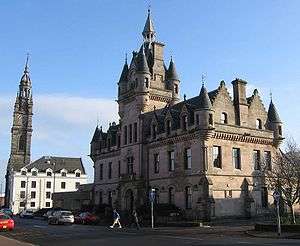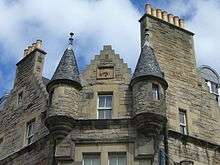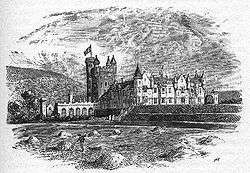Scottish baronial architecture

Scottish Baronial architecture (sometimes Baronial style) is a style of architecture with its origins in the sixteenth century. "Castle-like", the style draws on the features of Medieval castles, tower houses and the French Renaissance châteaux. Pioneered by figures including Sir Walter Scott, in the nineteenth century it was revived as part of the Gothic Revival and remained popular until World War I, with extensive use in Scotland and examples in Ireland, Canada, New Zealand and the United States.
Characteristics

Buildings of the style frequently feature towers adorned by small turrets called bartizans. Roof lines are uneven, their crenelated battlements often broken by stepped gables. While small lancet windows may appear in towers and gables, large bay windows of plate glass were not uncommon, but even these often had their individual roofs adorned by pinnacles and crenelation. Porches, porticos and porte-cocheres, were often given the castle treatment. An imitation portcullis on the larger houses would occasionally be suspended above a front door, flanked by heraldic beasts and other medieval architectural motifs.
This architectural style was often employed for public buildings, such as Aberdeen Grammar School. However, it was by no means confined to Scotland and is, in truth, a fusion of the Gothic revival castle architecture first employed by Horace Walpole for his Twickenham villa, Strawberry Hill, and the ancient Scottish defensive tower houses. In the 19th century it became fashionable for private houses to be built with small turrets and dubbed in Scottish Baronial style. In fact the architecture often had little in common with tower houses, which retained their defensive functions and were deficient with respect to 19th-century ideas of comfort.
The 20th-century Scottish Baronial castles have had the reputation of architectural follies. Among most patrons and architects the style became disfavoured along with the Gothic revival style during the early years of the 20th century.
Sixteenth to seventeenth centuries

The unique style of great private houses in Scotland, later known as Scots baronial, originated during the 1560s. It kept many of the features of the high walled Medieval castles that had been largely made obsolete by gunpowder weapons and may have been influenced by the French masons brought to Scotland to work on royal palaces. It drew on the tower houses and peel towers,[1] retaining many of their external features, but with a larger ground plan, classically a "Z-plan" of a rectangular block with towers, as at Colliston Castle (1583) and Claypotts Castle (1569-88). Particularly influential was the work of William Wallace, James VI's master mason from 1617 until his death in 1631. He worked on the rebuilding of the collapsed North Range of Linlithgow from 1618, Winton House for George Seton, 3rd Earl of Winton and began work on Heriot's Hospital, Edinburgh. He adopted a distinctive style that applied elements of Scottish fortification and Flemish influences to a Renaissance plan like that used at Château d'Ancy-le-Franc. This style can be seen in houses built for lords at Caerlaverlock (1620), Moray House, Edinburgh (1628) and Drumlanrig Castle (1675-89), and was highly influential until the baronial style gave way to the grander English forms associated with Inigo Jones in the later seventeenth century.[1]
Nineteenth-century revival
.jpg)

The Gothic revival in architecture has been seen as an expression of Romanticism and according to Alvin Jackson, the Scots baronial style was "a Caledonian reading of the gothic".[2] Some of the earliest evidence of a revival in Gothic architecture is from Scotland. Inveraray Castle, constructed from 1746 with design input from William Adam displays the incorporation of turrets. These were largely conventional Palladian style houses that incorporated some external features of the Scots baronial style. Robert Adam's houses in this style include Mellerstain and Wedderburn in Berwickshire and Seton House in East Lothian, but it is most clearly seen at Culzean Castle, Ayrshire, remodelled by Adam from 1777.[3]
Important for the adoption of the style in the early nineteenth century was Abbotsford House, the residence the novelist and poet, Sir Walter Scott. Re-built for him from 1816, it became a model for the modern revival of the baronial style. Common features borrowed from sixteenth- and seventeenth-century houses included battlemented gateways, crow-stepped gables, pointed turrets and machicolations.[4] Important for the dissemination of the style was Robert Billings' (1813-74) multi-volume Baronial and Ecclesiastical Antiquities of Scotland (1848-52).[5] It was applied to many relatively modest dwellings by architects such as William Burn (1789–1870), David Bryce (1803–76),[4] Edward Blore (1787–1879), Edward Calvert (c. 1847–1914) and Robert Stodart Lorimer (1864–1929) and in urban contexts, including the building of Cockburn Street in Edinburgh (from the 1850s) as well as the National Wallace Monument at Stirling (1859–69).[6] The rebuilding of Balmoral Castle as a baronial palace and its adoption as a royal retreat from 1855-8 confirmed the popularity of the style.[7]
In Ireland, a young English architect of the York School of Architecture, George Fowler Jones, designed Castle Oliver, a 110-room mansion of approx 29,000 sq ft (2,700 m2), built in a pink sandstone similar to Belfast Castle. Castle Oliver had all the classic features of the style, including battlements, porte-cochère, crow-stepped gables, numerous turrets, arrow slits, spiral stone staircases, and conical 'witch's hat' roofs.
This form of architecture was popular in the dominions of the British Empire. In New Zealand it was advocated by the architect Robert Lawson who designed frequently in this style most notably at Larnach Castle in Dunedin; now once again a private home, but open to the public. Other examples in New Zealand include works by Francis Petre. In Victoria, British Columbia, Craigdarroch Castle, built for Robert Dunsmuir, a Scottish coal baron, in 1890. In Toronto, E. J. Lennox designed Casa Loma in the Gothic Revival style for Sir Henry Pellatt, a prominent Canadian financier and industrialist. The mansion has battlements and towers, along with modern plumbing and other conveniences. Another Canadian example is the Banff Springs Hotel in the Banff National Park in Alberta, Canada. It can also be seen outside the empire at Vorontsov Palace near the city of Yalta, Crimea in modern-day Ukraine.
Decline
The baronial style peaked towards the end of the nineteenth century, and the building of large houses declined in importance in the twentieth century.[8] The baronial style continued to influence the construction of some estate houses, including Skibo Castle, which was rebuilt for industrialist Andrew Carnegie (1899–1903) by Ross and Macbeth.[8][9] Isolated examples included the houses designed by Basil Spence and built at Broughton Place (1936) and Gribloch (1937–39), which combined modern and baronial elements.[8]
See also
- List of Gothic Revival architecture
- DoCoMoMo Key Scottish Monuments
- Prospect 100 best modern Scottish buildings
Notes
- 1 2 J. Summerson, Architecture in Britain, 1530 to 1830 (Yale University Press, 9th edn., 1993), ISBN 0300058861, pp. 502-11.
- ↑ A. Jackson, The Two Unions: Ireland, Scotland, and the Survival of the United Kingdom, 1707–2007 (Oxford: Oxford University Press, 2011), ISBN 0-19-959399-X, p. 152.
- ↑ I. D. Whyte and K. A. Whyte, The Changing Scottish Landscape, 1500–1800 (London: Taylor & Francis, 1991), ISBN 0-415-02992-9, p. 100.
- 1 2 L. Hull, Britain's Medieval Castles (London: Greenwood, 2006), ISBN 0-275-98414-1, p. 154.
- ↑ T. M. Devine, "In bed with an elephant: almost three hundred years of the Anglo-Scottish Union", Scottish Affairs, 57, Autumn 2006, p. 11.
- ↑ M. Glendinning, R. MacInnes and A. MacKechnie, A History of Scottish Architecture: from the Renaissance to the Present Day, (Edinburgh: Edinburgh University Press, 2002), ISBN 978-0-7486-0849-2, pp. 276–85.
- ↑ H.-R. Hitchcock, Architecture: Nineteenth and Twentieth Centuries (New Haven, CT: Yale University Press, 4th edn., 1989), ISBN 0-300-05320-7, p. 146.
- 1 2 3 D. Mays, "Housing: 4 Country seat, c. 1600–Present", in M. Lynch, ed., Oxford Companion to Scottish History (Oxford: Oxford University Press, 2011), ISBN 0-19-969305-6, pp. 326–8.
- ↑ "New hotel is Scotland's first castle of the 21st century". Sourcewire. 10 August 2007.
External links
- Freewebs.com: The Scottish Baronial: an introduction and illustrations of five notable examples.
- Craigends.org.uk, a detailed study of "David Bryce's lost masterpiece", demolished in 1971.
- Castle-oliver.com, photographs and history of a recently restored Scottish Baronial masterpiece.